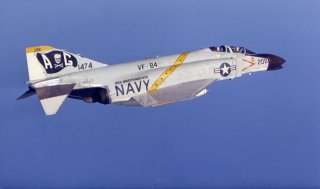This Plane Waged War for America in Vietnam. Now It Serves Iran.
Though the F-4 was eventually replaced by more capable F-15s and F-16s, these frames drew on lessons learned from the F-4s service history. Phantoms held their own up until Operation Desert Storm, where specially modified “Wild Weasel” F-4s were used in suppressing Iraqi air defenses. Not bad for a jet designed in the 1950s.
Key Point: These planes performed well and were used by several militaries. Here is its legendary story.
The F-4 Phantom was a beast of a jet. Despite early losses in Vietnam, the Phantom set sixteen world records and is still in service nearly sixty years after its first flight.
Beast
In an interview with an aviation website, Col. (Ret.) Charles B. DeBellvue, a former F-4 pilot, reminisced about his days flying the F-4 Phantom. “The F-4 was the last plane that looked like it was made to kill somebody. It was a beast. It could go through a flock of birds and kick out barbecue from the back.”
In the days before onboard computers and fly-by-wire flight controls, the pilot—and the pilot alone—was responsible for flying the airplane. “You didn’t get into the F-4, you put it on, it became you,” DeBellevue explained. It was a manual airplane, not like an F-16 or F-15, they were aerodynamic and designed well.”
The F-4 was a large, muscular twin-engine jet designed as an fighter-bomber and interceptor that was intended to rule the skies over Vietnam. When it debuted, in 1961, it was perhaps the most capable airframe for its role in the world.
The F-4 platform also set sixteen time-to-climb, altitude, and speed records. In 1959, the F-4 flew above 98,000 feet, and in 1961, the F-4 was the fasted jet in the world—2,581 kilometers per hour, or 1,604 miles per hour.
Vietnam
The airframe surrounded two engines that gave the F-4 a massive amount thrust. During engagements in Vietnam, American pilots were able to engage and disengage from engagements virtually at will—a tops speed over twice the speed of sound.
However, Vietnam revealed some glaring deficiencies with the F-4 design that needed to be rectified. The Air Force assumed that by relying on sheer speed, acceleration, and a high weapons load, the F-4 would destroy North Vietnamese MiGs.
Engineers estimated that dogfights at supersonic speeds would happen so fast, cannons would not be useful, so early-production airframes didn’t come equipped with any onboard guns.
At low speeds however, the F-4 was not very maneuverable, and was outfought by agile, tight-turning MiG-17s and MiG-19s. So F-4s were then equipped with an onboard 20 millimeter cannon after suffering an outsize number of losses against groups of MiGs using hit-and-run tactics.
Still Flying
The F-4 platform is still in service today with a few countries—nearly sixty years after introduction.
In 1971, Japan bought licenses for Mitsubishi Heavy Industries to build F-4s domestically. The first F-4 that Japan assembled, in 1971, carries out monthly flights for a surprising mission.
The F-4, #301, is equipped with a dust collection pod (“sniffer”) that samples the air in order to detect radioactive particles. In addition to monitoring North Korean nuclear tests, the sniffer monitors other environmental pollution.
Iran also flies American-built F-4s. In 2014, at least one F-4 was filmed on a bombing run in Iraq, though Iran has denied any involvement. As I wrote previously, F-4s in Iraq could be evidence of a non-interference agreement between the United States and Iran.
Into the Sunset
Though the F-4 was eventually replaced by more capable F-15s and F-16s, these frames drew on lessons learned from the F-4s service history. Phantoms held their own up until Operation Desert Storm, where specially modified “Wild Weasel” F-4s were used in suppressing Iraqi air defenses. Not bad for a jet designed in the 1950s.
Caleb Larson holds a Master of Public Policy degree from the Willy Brandt School of Public Policy. He lives in Berlin and writes on U.S. and Russian foreign and defense policy, German politics, and culture
This first appeared in 2020 and is being reposted due to reader interest.
Image: Reuters
More From The National Interest:
Russia Has Missing Nuclear Weapons Sitting on the Ocean Floor

